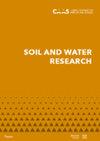自然富集和人为污染场地铬迁移率的比较:柱浸实验
IF 1.7
4区 农林科学
Q4 SOIL SCIENCE
引用次数: 0
摘要
本研究旨在比较两种不同Cr源土壤中铬的迁移率。第一个是来自活塞环生产厂区域的人为污染土壤,第二个是来自捷克共和国国家自然保护区Mohelno蛇形草原的自然增加的Cr含量的蛇形土壤。为了评估自然环境因素对Cr迁移率的影响,构建了酸化水处理(AW)和模拟根分泌物处理(SRE)两组柱淋试验。研究发现,与蛇纹石土壤相比,人工污染土壤(AW和SRE)的Cr浸出量都高出许多倍。总的来说,在两种处理下,所有样品都表现出从底层(分别是地平线)浸出的增强。只有人为土壤在底层表现出一定的差异,其对AW处理的敏感性高于SRE处理。这些结果表明,Cr的可浸出性与Cr含量来源高度相关。已经证明,与人为污染的土壤相比,来自基岩的铬含量升高的自然富集地点对铬浸出的抵抗力更强。本研究探讨了造成这些差异的可能原因。本文章由计算机程序翻译,如有差异,请以英文原文为准。
Comparison of chromium mobility at naturally enriched and anthropogenically polluted sites: A column leaching experiment
This study aims to compare the chromium (Cr) mobility in two soils with different Cr sources. The first one is an anthropogenically contaminated soil from an area of a piston ring production factory, and the second one is a serpentine soil with a naturally increased Cr level from the National Nature Reserve Mohelno serpentine steppe in the Czech Republic. To assess the influence of naturally occurring environmental factors on the Cr mobility, two sets of column leaching experiments were constructed, namely an acidified water treatment (AW) and a simulated root exudate treatment (SRE). It was found that the anthropogenically contaminated soil leached out many times more Cr for both (the AW and SRE) treatments in comparison with the serpentine soil. Generally, all the samples showed enhanced leaching from the bottom layer, respectively the horizon, for both treatments. Only the anthropogenic soil showed some differences in the bottom layer, which was more susceptible to the AW treatment than to the SRE one. These findings show the high dependence of the leachability of Cr on the Cr content origin. It has been proven that naturally enriched sites where elevated levels of Cr originate from the bedrock are more resistant to Cr leaching than anthropogenically contaminated soils. Feasible causes of these differences are discussed in this study.
求助全文
通过发布文献求助,成功后即可免费获取论文全文。
去求助
来源期刊

Soil and Water Research
Water resources, Soil Science, Agriculture-WATER RESOURCES
CiteScore
4.60
自引率
0.00%
发文量
26
审稿时长
>12 weeks
期刊介绍:
An international peer-reviewed journal published under the auspices of the Czech Academy of Agricultural Sciences and financed by the Ministry of Agriculture of the Czech Republic. Published since 2006.
Thematic: original papers, short communications and critical reviews from all fields of science and engineering related to soil and water and their interactions in natural and man-modified landscapes, with a particular focus on agricultural land use. The fields encompassed include, but are not limited to, the basic and applied soil science, soil hydrology, irrigation and drainage of lands, hydrology, management and revitalisation of small water streams and small water reservoirs, including fishponds, soil erosion research and control, drought and flood control, wetland restoration and protection, surface and ground water protection in therms of their quantity and quality.
 求助内容:
求助内容: 应助结果提醒方式:
应助结果提醒方式:


